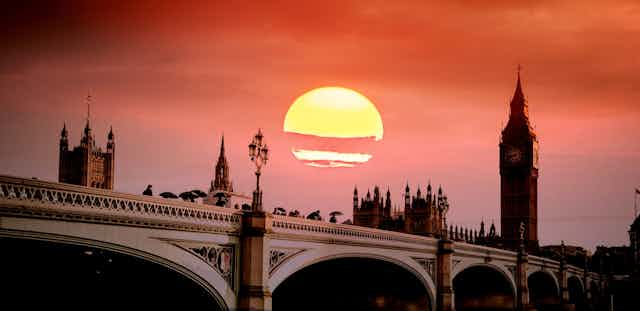The UK has experienced its hottest day on record, as provisional data showed the temperature soared to 40.3°C at Coningsby in Lincolnshire. This surpassed the previous record of 38.7°C set in Cambridge just three years previously. The unprecedented day followed a record warm night, when the 24-hour minimum temperature at Kenley in Surrey did not fall below 25.8°C, smashing the previous UK record by nearly two degrees.
As a historian of UK weather extremes and an expert in meteorological instruments, such records are of particular interest to me and other climate scientists. So what does a “new record temperature” actually mean, and what steps are taken to check its validity?
It’s not as simple as just noting the highest mark on a thermometer, as “records” can be influenced by faulty equipment or very local factors that have little to do with the weather. At a global level, the World Meteorological Organization (WMO) in Geneva has established clear guidelines for the identification and verification of new extremes and its website lists many records.
Inclusion on this list usually involves retrospective review by an expert committee, examining the details of the location, the instruments used, the reporting method and the like, followed by a recommendation whether or not to accept the new record.
Acceptance is not a given. While record temperatures of 54.0°C in Kuwait in 2016 and Pakistan in 2017 were verified, a 20.8°C measurement in Antarctica in 2020 – what would have been an Antarctic record – was rejected due to biases in the equipment.
The UK’s weather memory
In the UK, the Met Office is the agency responsible for the country’s “weather memory” and tends to act as the sole arbiter of the validity (or otherwise) of weather extremes. It occasionally gets this badly wrong.
For instance, in June 2018 it announced a reported temperature of 33°C in Motherwell had set a new Scottish record. Unfortunately photographs quickly emerged showing that the temperature sensor involved sat near to the generator from a stationary ice-cream van which had been pumping out heat all day long.
The record was swiftly retracted, with rather red faces at the Met Office HQ in Exeter. The announcement of the more recent temperature record is careful to highlight that the data is still to be confirmed.

The Met Office’s UK network consists of about 270 mostly-automated weather stations which report hourly conditions day and night. Then there is an additional network of about 150 so-called climatological stations which send reports once daily or even once monthly.
Most of the known extremes of past British weather originate from these sites and some of these records are decades old. For example, northern England’s lowest temperatures reached in January 1881 have not been beaten since then.
Not surprisingly, climate change means the UK’s highest temperatures are now being regularly broken, and not just in summer. In 2019 alone, new monthly records were set in February, July and December.
But the recent increase in record-breaking temperatures is also partly because weather stations are more evenly distributed these days, which means localised extremes are more likely to be recorded.
Some extremes are examined retrospectively, and older records may be removed from the list if there is any doubt about the accuracy of the instruments or the site conditions. For instance, a 1970s analysis of 38°C temperatures recorded in Kent during the hot summer of 1868 downgraded the likely temperatures to around 36°C, following careful consideration of the way thermometers were exposed at that time.
Approved sites only
For a new temperature record to be accepted, it normally originates only from a Met Office approved site. Temperatures can be considered only where the thermometers, or electronic sensors, are housed in a white double-louvred enclosure known as a Stevenson screen, mounted 1.25 metres above short grass (the standard since the 1880s). A Stevenson screen protects the thermometer from direct sunlight and prevents rain or snow falling on the sensors, while still admitting some air movement.
Where there are larger differences from nearby stations, the weather station site itself may be suspect. Hedges may have grown too tall and started sheltering the instruments, or the instrument’s calibration may have drifted, or something similar. In one instance I observed myself at Kew Gardens in London a few years back, a barbecue marquee had been built butting right up to the weather station railings – no wonder Kew was the hottest place on that particular day.
When an extreme occurs at a Met Office site, the weather station is visited by an inspector, usually within a few days. The inspector will talk to the observer, carefully examine the surroundings (no ice-cream vans nearby? Good…), check the condition of the Stevenson screen and the calibration of the thermometers, and so on, before provisionally accepting or refuting the validity of the record.
To comply with WMO recommendations, such inspection reports as well as all the relevant data, site photographs and the like should be put into the public domain for subsequent review by an independent panel: unfortunately, the Met Office rarely makes these available for scrutiny.
As a result, decision-making regarding record validity is rarely as transparent as it should be. No doubt the Met Office will shortly be sending its inspector to Coningsby. We deserve to know more about what they find.

Don’t have time to read about climate change as much as you’d like?
Get a weekly roundup in your inbox instead. Every Wednesday, The Conversation’s environment editor writes Imagine, a short email that goes a little deeper into just one climate issue. Join the 10,000+ readers who’ve subscribed so far.

